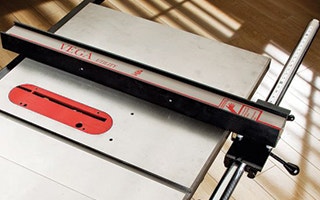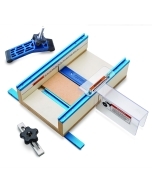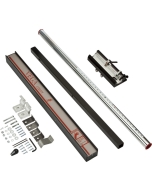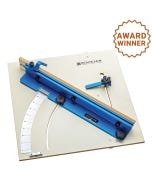Fence Systems for Accurate Table Saw Ripping
Ripping wood is a primary function of the table saw, and because its importance, many manufacturers pay particular attention to the quality the rip fence on the saws they offer. Still, many factory fence systems lack the reliability and precision that would qualify them for exacting work.
In this article, we'll look at the basic requirements for good table saw ripping, and how an after-market fence system, like the Vega Fence System, can improve the ripping performance of a saw that's suffering from "fence problems."
Is Your Rip Fence Up to Par?
What makes a good rip fence? One of the most important factors is whether the fence offers reliable parallel alignment with the blade. When you lock a rip fence in position, it should be automatically drawn into near-perfect parallel alignment with the saw's blade, and this should happen unfailingly you shouldn't have to make frequent adjustments to the fence, or meddle with it to get it aligned. This is a very important point - accurate ripping, a clean cut, and even your safety depend on this alignment.
Checking for Parallel Alignment
Checking the parallel alignment of you table saw's rip fence is the first step in evaluating your saw's rip fence. But to check the alignment of the rip fence, you first need some information about the alignment of the blade in relation to the table saw's miter slot. For accurate ripping and crosscutting on a table saw, the blade must be in parallel alignment with both the miter slot and the fence. Since the miter slot cannot be "adjusted," the first step in the alignment process is to bring the table saw blade into alignment with the miter slot.
Aligning the Table Saw Blade

For the most accurate table saw adjustments, consider a precision alignment tool. A Table Saw Gauge reconfigures in seconds to test table saw alignment, arbor shaft runout, blade and flange runout, and rip fence alignment and straightness.
The procedure for aligning the table saw blade with the miter slot varies from saw to saw. The owner's manual for your saw is the best source of information for making this adjustment. In brief, the procedure for aligning the blade with the miter slot goes as follows:
Mount a blade in the saw and raise it to its highest position. Lay a straight edge on the surface of the table so that it is centered across the diameter of the blade and tight up against the blade plate (make sure that the straightedge is in contact with the blade plate itself, and not resting on the blade's carbide teeth).
Next, measure the distance from the straightedge to the miter slot milled in the surface of the table at each end of the straightedge. If the measurements do not agree, the blade is out of alignment. Follow the manufacturer's instructions for adjusting the blade alignment. In most cases this will involve losing three of the four bolts that attach the trunnions to the saw, tapping the assembly into the correct position and retightening the bolts (be sure to check the alignment again when you are finished to make sure that the act of tightening the bolts didn't pull the blade out of alignment).
Checking for Parallel Fence Alignment
Now you are ready to check the alignment of the fence. Since the blade is now in parallel alignment with the miter slot, you could simply check the alignment of the fence against the miter slot, but a more accurate reading is supplied by setting the fence in a few positions at varying distances from the blade and using the straightedge again to check the alignment of the surface of the fence and the surface of the blade. The measurements of the distance from the surface of the fence at the front end of the fence and the back end of the fence to the straightedge should agree.
If they don't, the fence is out of alignment and should be adjusted. Most fences have a provision for adjusting parallel alignment - again, the manufacturer is the best source of information on the procedure. If the fence cannot be accurately adjusted, or if the degree of disagreement between alignment measurements varies as the fence is positioned and repositioned, there is a strong possibility that your current fence is incapable of providing reliable parallel alignment. If you are generally satisfied with your saw's other qualities, correcting the problems with the fence is worth considering.
Other Rip Fence Considerations
Along with providing reliable parallel alignment, a good fence is also easy to accurately position at the desired distance from the blade. The positioning scale on the front fence rail should be easy to read, and the fence should have a cursor that can be accurately calibrated to produce precise settings. A useful fence also needs to have a wide enough capacity to do the work you need it to do. If the fence on your saw falls short of either of these additional criteria, and a new saw that comes with a better fence isn't in the plan, an after-market fence system is the best solution.
Keep the inspiration coming!
Subscribe to our newsletter for more woodworking tips and tricks




